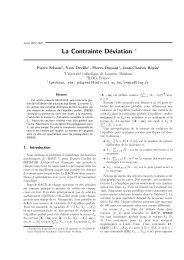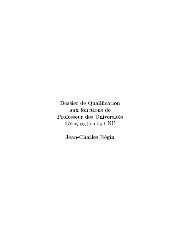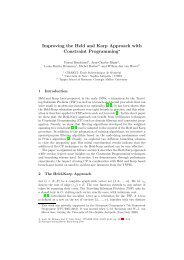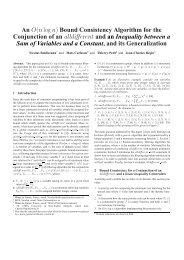Note that none of these balance criteria subsumes the others. For instance,the minimization of L 1 does not imply in general a minimization of criterionL 2 . This is illustrated on the following example. Assume a constraint problemwith four solutions given in Table 1. <strong>The</strong> most balanced solution <strong>de</strong>pends onthe chosen norm. Each solution exhibits a mean of 100 but each one optimizesa different norm.sol. num. solution L 0 L 1 L 2 L ∞1 100 100 100 100 30 170 2 140 9800 702 60 80 100 100 120 140 4 120 4000 403 70 70 90 110 130 130 6 140 3800 304 71 71 71 129 129 129 6 174 5046 29Table 1. Illustration showing that no balance criterion <strong>de</strong>fined by the norm L 0, L 1,L 2 or L ∞ subsumes the others. <strong>The</strong> smallest norm is indicated in bold character. Forexample, solution 2 is the most balanced according to L 1.<strong>The</strong> norm L ∞ has already been used in two previous works [2, 4] to solveBACP. SPREAD is a constraint for L 2 [5, 7]. A constraint for L 0 can easily beimplemented using an ATLEAST(i, [X 1 , ..., X n ], m) constraint for |{X ∈ X |X ≠m}| ≤ i and a SUM([X 1 , ..., X n ], n.m) constraint to ensure a mean of m. In thispaper, a global constraint and its propagators for the L 1 norm with fixed meanis presented. This constraint is formulated in the following <strong>de</strong>finition:Definition 1. A set of finite domain integer variables X = {X 1 , X 2 , ..., X n },one mean value m and one interval variable D are given.<strong>The</strong> constraint DEVIATION(X , m, D) states that the collection of values takenby the variables of X exhibits an arithmetic mean m and a sum of <strong>de</strong>viations tom of D. More formally, DEVIATION(X , m, D) holds if and only ifn.m =n∑X i and D =i=1n∑|X i − m|.For the constraint to be consistent, n × m must be an integer. As a consequencen × D is also an integer.i=1Outline of the paper:Section 2 mainly reviews preliminaries notions relative to constraint programmingsuch as filtering, domain-consistency and bound-consistency. We also <strong>de</strong>finesome useful notations. Section 3 motivates the need of a global filtering algorithmfor DEVIATION in terms of filtering. Section 4 explains the propagatorsnarrowing the domain of D. This filtering makes use of the minimization andmaximization of the sum of <strong>de</strong>viations. <strong>The</strong> minimization is solved in linear2
time. <strong>The</strong> maximization is proved to be N P-complete; however, an approximatedupper bound can be calculated in linear time as well. Section 5 <strong>de</strong>scribesthe filtering algorithm from m and D to the variables X . <strong>The</strong> i<strong>de</strong>a is similar to abound consistency filtering algorithm for a SUM constraint but including the sumof <strong>de</strong>viations constraint. Section 6 shows that our propagators do not achievebound-consistency. Section 7 gives a relaxation of SPREAD with DEVIATION. Finally,Section 8 evaluates the efficiency of the presented propagators in terms offiltering on randomly generated instances.2 Background and notationsBasic constraint programming concepts largely inspired from Section 2 of [8] areintroduced.Let X be a finite-domain (discrete) variable. <strong>The</strong> domain of X is a set ofor<strong>de</strong>red values that can be assigned to X and is <strong>de</strong>noted by Dom(X). <strong>The</strong> minimum(resp. maximum) value of the domain is <strong>de</strong>noted by X min = min(Dom(X))(resp. X max = max(Dom(X)). Let X = {X 1 , X 2 , ..., X k } be a sequence of variables.A constraint C on X is <strong>de</strong>fined as a subset of the Cartesian product ofthe domains of the variables in X : C ⊆ Dom(X 1 ) × Dom(X 2 ) × ... × Dom(X k ).A tuple (v 1 , ..., v k ) ∈ C is called a solution to C. A value v ∈ Dom(X i ) for somei = 1, ..., k is inconsistent with respect to C if it does not belong to a tuple ofC, otherwise it is consistent. C is inconsistent if it does not contain a solution.Otherwise, C is called consistent.A constraint satisfaction problem, or a CSP , is <strong>de</strong>fined by a finite sequenceof variables X = {X 1 , X 2 , ..., X n }, together with a finite set of constraint C eachon a subset of X . <strong>The</strong> goal is to find an assignment X i := v with v ∈ Dom(X i )for i = 1, ..., n, such that all constraints are satisfied. This assignment is calleda solution to the CSP .<strong>The</strong> solution process of constraint programming interleaves constraint propagation,or propagation in short, and search. <strong>The</strong> search process essentially consistsof enumeration all possible variable-value combinations, until a solution isfound or it is proved that none exists. We say that this process constructs asearch tree. To reduce the exponential number of combinations, constraint propagationis applied to each no<strong>de</strong> of the search tree: Given the current domainsand a constraint C, the propagator for C removes domain values that do notbelong to a solution to C. This is repeated for all constraints until no more domainvalue can be removed. <strong>The</strong> removal of inconsistent domain values is calledfiltering.In or<strong>de</strong>r to be effective, filtering algorithms should be efficient, because theyare applied many times during the search process. <strong>The</strong>y should furthermoreremove as many inconsistent values as possible. If a filtering algorithm for aconstraint C removes all inconsistent values from the domains with respect toC, we say that it makes C domain-consistent. It is possible to achieve domainconsistencyin polynomial time for some constraints such as AllDiff but forother constraints such as SUM this would be too costly. In such cases a weaker3







